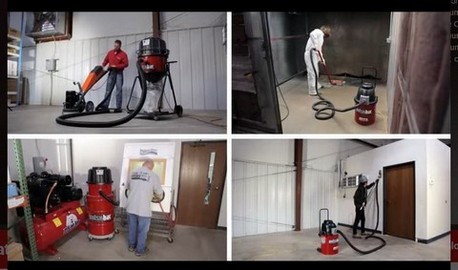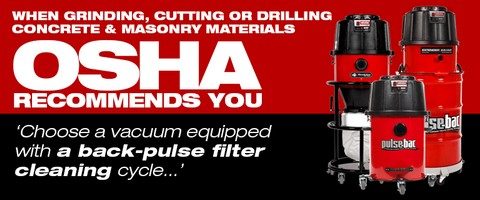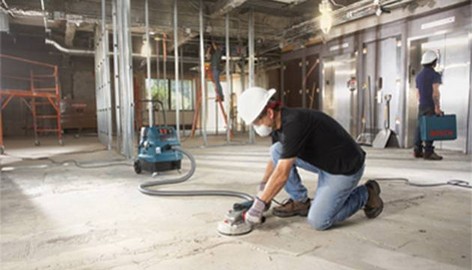**** OSHA UPDATE 4/7/2017 – New OSHA Deadline is September 23, 2017 for Silica Dust Compliance as there was a 90 day extension added.
As the OSHA’s silica June 23, 2017 compliance deadline is rapidly approaching, do you know which dust collection vacuum complies? Do you know how often filters need to be changed? Do you know the filter efficiency standard? If you answered no to any of these questions, don’t worry, in today’s Coptool post we will discuss OSHA’s silica regulation and approved products to ensure you’re in compliance!
OSHA has issued two standards in an effort to protect millions of construction workers from crystalline silica – one for construction and the other for general industry and maritime. Throughout this post, we will be focusing on the construction standard. OSHA recognizes that current silica regulations do not provide adequate protection for construction workers. With the new standard, OSHA is reducing the permissible exposure limit to 50 micrograms per cubic meter of air over 8 hour time weighted average. Basically 1/5 of the previous standard of 250 micrograms per cubic meter of air over 8 hour time weighted average. Check out the Pulse-Bac Vacuum video above, they do the best job we have seen for outlining the basic details.
As most of us know, silica can be found in concrete, brick, stone and other masonry products. And when silica amounts raise above the standard of 50 micrograms per cubic meter of air over 8 hour time weighted average, a dust collection system (vacuum) must be used. Dust collecting systems must provide enough air flow in accordance to the tool manufacturer’s recommendations and have a filter efficiency of 99% or higher. Dust collectors are required for cutting fiber cement board, tuck pointing, dowel drilling concrete and hand held and stand mounted drills. Tools such as jack hammers, chipping tools (i.e. – hammers drills), hand held grinders and walk-behind grinders require dust collection systems (or water delivery systems). While HEPA filters are not required, they are certainly a good idea and provide excellent filter efficiency!
Pulse-Bac, a manufacturer of dust collection systems conducted research on air flow efficiencies and concluded that air flow can significantly be reduced, as much as 50% as filters become clogged. That’s why they developed a patented technology called “Pulse-Bac Automated Pulse-Clean Technology”. Their innovative self-cleaning system allows the vacuum to handle dust without clogging the filter by automatically pulsing the filter clear of dust and debris during operation, using only ambient air and vacuum.
This revolutionary system saves time, making the job easier without the need to stop work to inspect filters. Pulse-Bac vacuum systems are fully automatic, no blowers, shakers, compressors or buttons to push and meets OSHA, NIOSH and EPA requirements. Their filters exceed OSHA’s HEPA certification requirements. And not only does Pulse-Bac offer HEPA approved filters, they provide HEPA certified models that come with advanced Cyclonic Debris Management System. While Pulse-Bac models exceed OSHA’s 2017 silica regulations, other manufacturers such as Bosch and Dustless provide approved products as well.
Similar to Pulse-Bac’s automated cleaning cycle, Bosch, Makita, CS Unitec and others offer similar system in which it automatically clean the filter every 15 seconds, provides excellent power between vacuum and connected tools to allow maximum suction control. These units will top out between 125 & 150 CFM, which will comply with 5″ or 6″ blades for cutting/grindering applications where as Pulse-Bac will go up to 690 CFM.
Dustless is another dustless vacuum brand that provides HEPA certified filters and dust collection systems. This this unit however does not offer an “automated filter cleaning mechanism”. OSHA’s filter cleaning guidelines state the following, “the filter(s) on the vacuum must be cleaned or changed as frequently as necessary in order to ensure they remain effective (it may be necessary to activate a back-pulse filter cleaning mechanism several times during the course of the shift) regular stops to conduct the proper reverse air pulse filter cleaning procedure were crucial to successful dust control”.
Depending on the level of dust collected, filters may need cleaned and bags replaced often. The Dustless Wet Dry Extraction Vacuum can pick up an impressive 40lbs. of dust and water at the same time. Even with a HEPA vac, if it doesn’t have auto cleaning mechanism you certain could be opening yourself up to potential issues which is why this new OSHA Silica Dust regulation is soooo tricky. For further information on this unit, please view the video below.
There are many professional vacs with various different functions from Pulse-bac, Bosch, Makita (corded or cordless vacs), Metabo, CS Unitec, Ridgid and Dustless, which can all be found at Ohio Power Tool, give their pros a call 800-0242-4424 with any product specific questions.
For further information or have questions about OSHA Silica Dust regulations contact a qualified safety professional (our friends at SAFEX are just one example). If your company works with Silica you will need professional training before the June 23rd deadline, get it done now while it’s cold out!


